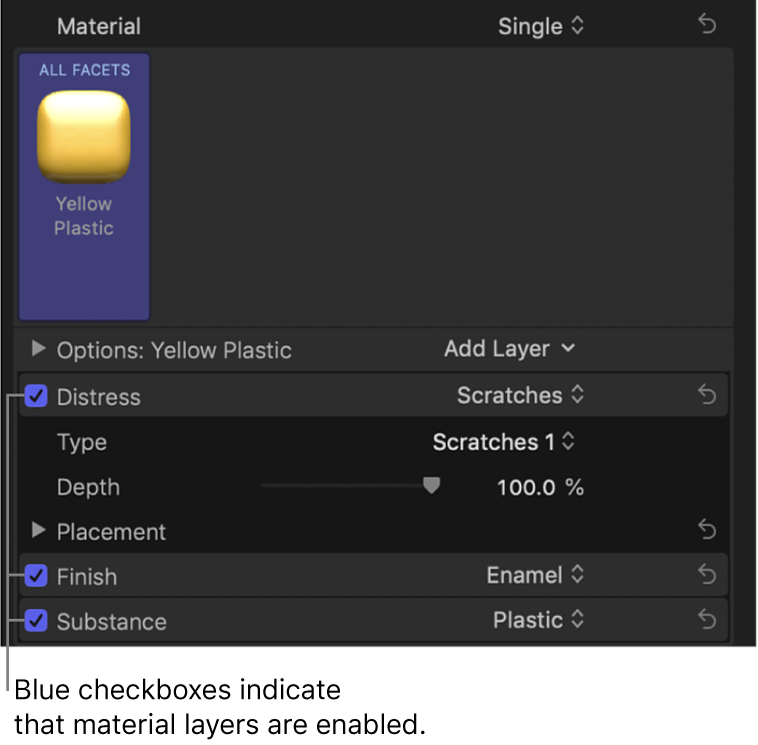Final Cut Pro X User Guide
- Welcome
-
- What’s new in Final Cut Pro 10.4.7
- What’s new in Final Cut Pro 10.4.6
- What’s new in Final Cut Pro 10.4.4
- What’s new in Final Cut Pro 10.4.1
- What’s new in Final Cut Pro 10.4
- What’s new in Final Cut Pro 10.3
- What’s new in Final Cut Pro 10.2
- What’s new in Final Cut Pro 10.1.2
- What’s new in Final Cut Pro 10.1
- What’s new in Final Cut Pro 10.0.6
- What’s new in Final Cut Pro 10.0.3
- What’s new in Final Cut Pro 10.0.1
-
- Intro to effects
-
- Intro to transitions
- How transitions are created
- Set the default transition
- Add transitions
- Delete transitions
- Adjust transitions in the timeline
- Adjust transitions in the inspector and viewer
- Merge jump cuts with the Flow transition
- Adjust transitions with multiple images
- Modify transitions in Motion
-
- Add storylines
- Use the precision editor
- Conform frame sizes and rates
- Use XML to transfer projects
-
- Glossary
- Copyright

Work with 3D text material layers in Final Cut Pro
You can add multiple material layers to create more complicated textures for your 3D titles. For example, if you combine an Aluminum substance layer with a Grey Granite substance layer, your 3D text takes on a metallic ore finish that may or may not exist in nature. Likewise, you can add paint layers, finish layers, distress layers, and emit layers to create highly realistic (or highly fanciful) textures that show signs of aging, dirtiness, radiance, and other real-world qualities.
The order in which material layers are applied affects the appearance of the object. For example, you might add a wood surface layer, a paint layer, and various distress layers to create a material that looks like painted wood that is aged and worn. Each layer affects the layers stacked beneath it in the Text inspector, and rearranging the layers creates different results.
You can also remove, rearrange, or temporarily disable material layers.
Add a material layer to a 3D texture
Select a 3D title in the Final Cut Pro timeline.
If the inspector isn’t already shown, do one of the following:
Choose Window > Show in Workspace > Inspector (or press Command-4).
Click the Inspector button on the right side of the toolbar.

Click the Text button at the top of the inspector.

Tip: Double-click the top bar of the inspector to switch between half-height view and full-height view.
In the Material section of the 3D Text section, click the Add Layer pop-up menu, then choose a new material layer type (Substance, Paint, Finish, Distress, or Emit) and subtype.

The new material layer and its adjustable controls appear in the Material section.
To add another material layer, repeat step 4.
Adjust the material layer controls in the Material section to achieve the look you want.
For more information about material layer controls, see Intro to Material controls in Final Cut Pro.
Enable or disable material layers
You can temporarily turn off or turn on any material layer to see how it’s affecting the overall texture.
In the Material section of the 3D Text section of the Final Cut Pro Text inspector, click the checkbox to the left of the material layer type (Substance, Paint, Distress, and so on).
When the checkbox is highlighted blue, the effect of the material layer is visible in the viewer. When the checkbox is not highlighted, the effect is turned off.

Rearrange the stacking order of material layers
The stacking order of material layers in the Material section of the Text inspector affects a 3D texture’s appearance in the viewer. You can rearrange the stacking order to create different looks.
In the Material section of the 3D Text section of the Final Cut Pro Text inspector, drag a material layer name (Substance, Paint, Distress, and so on) to a new position in the stack.
Remove a material layer
In the Material section of the 3D Text section of the Final Cut Pro Text inspector, click a material layer name (Substance, Paint, Distress, and so on), then press Delete.
Tip: To select and modify multiple material layers at once (for example, to delete or rearrange all the layers), Shift-click or Command-click the layers.